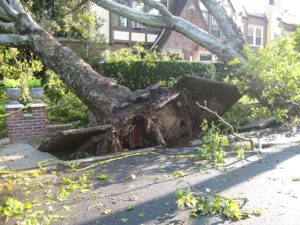
Winter of 2018 has been especially devastating one homeowners concerned about property damage was falling trees. Heavy winds along with three Nor’easters this winter have contributed to not only falling trees damaging houses but also bringing down power lines. This is especially dangerous as many of these trees are falling on the roadways where people drive. It also can be dangerous with downed power lines that in many cases police will ask residents to stay indoors so they would not be in danger of live wires.
Many people wonder why trees fall down in these high winds and especially why certain trees. The main reason trees fall down is because of shallow roots roots. Roots which are important for absorbing water, also act as a tree’s anchor keeping the tree upright so if a tree has root issues, heavy winds could essentially uproot it and knock it over.
While trees with shallow roots tend to fall over and more easily, certain species of trees are the most susceptible. The most common trees that you will see fall over and wind tend to be white pine, Cedar, Willow and white spruce.
You can usually tell when trees could topple or other signs that they may fall over as there are telltale signs. Many times the tree that’s at risk of falling over has had some of its roots compromise maybe there is been excavation done nearby, or a trench has been dug. If you see a lot of mushroom growth at the base of the trunk or on the root system that can be an obvious sign of the tree is dead or decaying from rot. Some trees may just be at risk of falling over because they’re very old while there are trees that can live up to 100 or 150 years many trees. Many trees simply have a shorter lifespan.
If you were concerned about trees falling over or uprooting during the storm there are a couple of things you can do to help prevent this. You can water your trees frequently so that the trees roots will grow closer to the surface. Make sure that your watering can your hose is only turned on to a small dribble and keep it near the major root zone leave it on for 2 to 3 hours. And then you can do that in another area of the roots do this a couple of times and you should do it once or twice a week. But make sure you don’t put too much water on your tree or you can drown it. Also make sure that any large dead limbs or giant branches are removed. If you do find that you need your tree professionally assessed and you’re searching on your phone for tree service near me, call one of the friendly tree companies nearby.